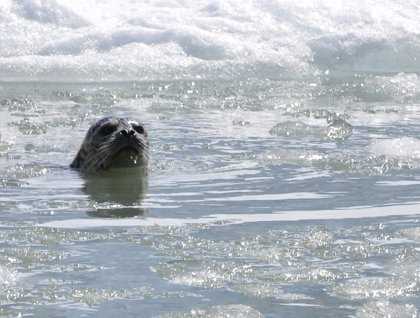Sun bounced off the white snow-capped mountains rising straight out of the salty fjord waters as the National Geographic Sea Bird wound her way through a scattering of blue icebergs toward the face of South Sawyer Glacier. From our expedition landing craft, the cerulean ice enchanted us; smooth sculpted surfaces reminded me of art deco glass sculpture on a scale unimaginable by the human artist…such immense and captivating beauty that changes by the hour and will disappear in a week!
Out in the brash ice, harbor seals were abundant. Poking their rounded silvery heads between the icy bits, these large-eyed pinnipeds charmed us with their curious looks and quick movements. In the distance we could see many seals hauled out on floating ice—likely they are pregnant females about to birth their pups. The female harbor seals will nurse their young for three to six weeks and about the time the salmon enter the spawning streams, the mothers and their young will depart for some serious feeding. We could learn much from nature’s exquisite timing.
Winding our way out of the fjord from the beautiful bare rock uncovered by the glacier toward the temperate rain forest that was glaciated long ago, spring is becoming more evident in the greening hillsides. Just after lunch, sharp-eyed Melanie spotted two handsome bears eating grass in the intertidal area. At first they looked brown, well they were brown or as it turns out, not brown bears but cinnamon colored black bears as color is not a reliable indicator for the two bear species we see here in Southeast Alaska. These coastal bears have recently left their winter dens above tree line and are out searching for new shoots and intertidal tidbits to sustain them. They too await the arrival of the salmon in mid-July.
As a sweet topping to an already full day, we stopped in Williams Cove and enjoyed an exploratory walk or kayak in the luscious deep green, moss-covered, lichen-draped forest that characterizes this region.







